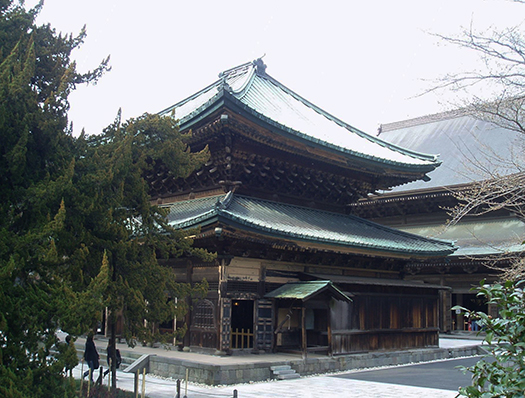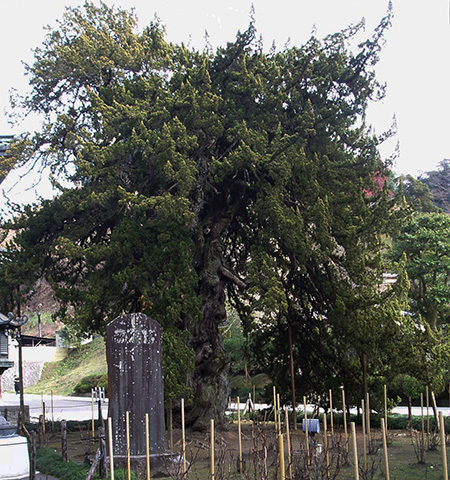

きのう見たとおり、鎌倉幕府創始と深く関わる奥州・平泉の藤原政権。
こちらが創建した中尊寺は頼朝の侵攻時、なんとか存続されることになった。
侵略者頼朝としては、配下の関東御家人・開墾地主層に対して
「御恩」としての奥州の土地分配を平和的に権利移行させるのに
無用の混乱を避けることが優先されたのだろう。
また中尊寺はあらたな支配者に対し迎合的な対応で終始したことが想像される。
その中尊寺は天台宗であり比叡山・慈覚大師円仁の創建とされていたことから
朝廷の保護もあったものと思われる。
関東の武権に立脚した頼朝としても今後の政戦を考えれば、義経を口実として
藤原氏を殲滅したことで全国的な「治政」一元支配が完成したので
将軍権威としての「政治」優先に姿勢に転換して行ったのでしょう。
中尊寺は天台宗、浄土思想が鮮明な宗旨だった。
清衡の「願文」でも浄土に往生するという救済思想が強く感じられる。
この藤原氏の宗教政策に対して鎌倉政権は新宗教としての大陸直輸入の
禅宗寺院を対置していったのがこの建長寺。
鎌倉の宗教政策は、それまでの京都中心の旧仏教、
平泉藤原政権も受容していた天台などの思想ではなく、
このような舶来の新仏教を導入していくことになる。
武士階級の個人主義的・内省的克己心涵養型の禅宗志向が基礎だろうけれど、
政治的には旧時代の宗教政策からの転換を意図していたと思われる。
当初は鶴岡八幡という源氏の素性をあらわす神道を前面に押し出しつつ、
幕府樹立から数十年経過後、こうした仏教政策を推進した。
幕府指導者としての頼朝として、明確な仏教政策を持っていなかったかも。
というか、鎌倉幕府の意思決定主体は開墾地主御家人の連合体なので、
そういった宗教政策について決定を下せる素地がなかったのかも知れない。
あらたな政治権力中枢としての経験値が不足していて
「え、そんなことまで決めなきゃいけないの?」というのが
かれらの実質だったのではないか。道元が鎌倉に招聘されて
鎌倉の禅宗寺院開山者として擬定されていたとき、
幕府の権力者たちが前時代的、原始的な加持祈祷にふけっている様子を見て
開山者となることを辞退したと言われている。
貴族階級からの出自である道元には「こんな連中」という思いもあったのだろう。
そうした経緯から幕府としては当時宋から来日して名高かった蘭渓道隆を
見出してかれを国家事業としての禅宗寺院開山者として指名した。
そのようなことなのでこの建長寺には舶来の香木として
直輸入の柏槇が蘭渓道隆の「手植え」という伝承とともに植えられている。
見たこともない植物と寺院内での公用語に中国語が用いられたことなど、
日本社会に根強い「舶来信仰」の関東での初源を見るような気がする。
はるかな後世の横浜などの「洋風迎合」ぶりとかぶるかも知れない。
蘭渓道隆はしかしその後の蒙古襲来時、スパイ疑惑で一時失権し、
またその後も舶来の導師が住持として迎えられたが根付いたとは思えない。
1293年4月13日、鎌倉は大地震に襲われ建長寺は炎上した。
関東という地域が歴史年代で繰り返し襲われた地震災害の始まりともいえる。
English version⬇
[Hodo and Kaisan, Lanxi Daolong hand-planted Kashiwamaki Kenchoji-8]
As you saw yesterday, the Fujiwara administration of Hiraizumi, Oshu, is deeply involved in the founding of the Kamakura Shogunate.
Chuson-ji, which was built here, managed to survive during the invasion of Yoritomo.
As an invader, Yoritomo, against his subordinate Kanto gokenins and landowners
To peacefully transfer the rights of Oshu’s land distribution as a “gratitude”
Perhaps the priority was to avoid unnecessary confusion.
In addition, it is conceivable that Chuson-ji started with a compliant response to the new ruler.
The Chuson-ji Temple was a Tendai sect and was founded by Ennin, a master of Mt. Hiei.
It seems that there was also the protection of the imperial court.
Yoritomo, who was based on the military power of the Kanto region, used Yoshitsune as an excuse when considering future political warfare.
By annihilating Mr. Fujiwara, a nationwide unified rule of “government” was completed.
He must have changed his stance to prioritize “politics” as a general authority.
Chuson-ji was a sect with a clear Tendai sect and Pure Land Buddhism.
Even in Kiyohira’s “Request”, the relief idea of getting stuck in the Pure Land is strongly felt.
In response to Mr. Fujiwara’s religious policy, the Kamakura administration imported directly from the continent as a new religion.
This Kenchoji Temple is the opposite of the Zen Buddhist temple.
Kamakura’s religious policy was the old Buddhism centered on Kyoto until then.
It is not the idea of Tendai that the Hiraizumi Fujiwara administration accepted, but
This kind of new Buddhism will be introduced.
Although it may be based on the samurai class’s individualistic and introspective self-recharge-type Zen Buddhism orientation,
Politically, it seems that it was intended to shift from the religious policy of the old era.
At first, while pushing the Shinto that expresses the identity of Genji called Tsurugaoka Hachiman to the front,
Decades after the establishment of the Shogunate, he promoted such a Buddhist policy.
As Yoritomo as a leader of the shogunate, he may not have had a clear Buddhist policy.
In fact, the decision-making body of the Kamakura Shogunate is a coalition of landowners and gokenins.
Perhaps there was no basis for making such religious policies.
Insufficient experience as a new political power center
“Well, do I have to decide that?”
Wasn’t it their substance? Dogen was invited to Kamakura
When I was masqueraded as the founder of the Zen Buddhist temple in Kamakura,
Seeing the powers of the shogunate indulging in prehistoric and primitive Kamochi prayers
He is said to have declined to be a pioneer.
Dogen, who was born from the aristocratic class, probably had the idea of ”these people.”
From such a background, Lanxi Daolong, who was famous as a shogunate when he came to Japan from Song at that time,
He was found and nominated him as the founder of the Zen Buddhist temple as a national project.
Because of that, as a scented tree that came to Kenchoji
Directly imported Kashiwamaki is planted along with the tradition of “hand-planting” by Lanxi Daolong.
Chinese was used as the official language in the temple and plants that I had never seen, etc.
I feel like seeing the first source of “imported faith” in the Kanto region, which is deeply rooted in Japanese society.
It may be worn for the first time in “Western style acceptance” such as Yokohama in the distant future.
However, when Lanxi Daolong invaded Mongol, he was temporarily forfeited on suspicion of being a spy.
After that, a priest from Japan was welcomed as a priest, but I don’t think it has taken root.
On April 13, 1293, Kamakura was hit by a big earthquake and Kenchoji was on fire.
It can be said that it is the beginning of an earthquake disaster that repeatedly hit the Kanto region in the historical age.
Posted on 12月 23rd, 2021 by 三木 奎吾
Filed under: 住宅マーケティング, 日本社会・文化研究, 歴史探訪







コメントを投稿
「※誹謗中傷や、悪意のある書き込み、営利目的などのコメントを防ぐために、投稿された全てのコメントは一時的に保留されますのでご了承ください。」
You must be logged in to post a comment.